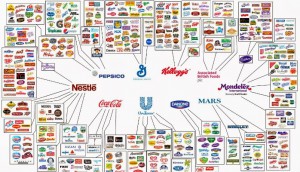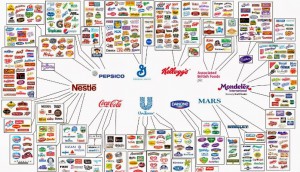Spotlight: Fast Moving Consumer Goods get faster and faster

FMCG markets are maturing rapidly making profit growth a game of marginal gains. Fast Moving Consumer Goods (FMCG) and Consumer Packaged Goods (CPG) are the two names for the sector that so many of us interact with every day. Over thirty years, the sector that covers food, beverages, personal care, and much else sold by the larger generalist retailers has grown massively on the back of increasing disposable income in developed countries and the rapidly expanding and aspirational middle classes of the developing world. Global powerhouses like Nestlé, P&G, Unilever, Mondelez, General Mills, Coca-Cola and Pepsi dominate with global branding supported by vast marketing budgets. These companies are the visible and high profile manifestation of our capitalist, free-thinking economies.
Change is afoot, but you’d not pick that up from the bullish attitudes of these companies and their hugely successful marketing machines, nor even from much of the business world’s commentary. The plain fact is that “fast” markets are a magnet for competition. That competition squeezes profit as the market is so filled with good options for us consumers – whether from the large companies or from the entrepreneurs whose business visions have been facilitated so excellently in our digital age. The developed market’s tendency to eat about 30% more than we actually need (or is good for us …) has contributed to the current but only slowly dawning realization that a market correction is in play.
The growth formula for the last thirty years will not be extended any longer. How can a business sell 30% less volume and yet deliver continued financial growth to its shareholders? Anticipating these changes, the major companies have been busy switching investment into economies with growth potential and harvesting developed markets for profit to invest elsewhere, but these growing markets are, in many cases, changing even more rapidly than their developed country cousins. Countries like China and India are learning the lessons even before they themselves have gone through the period of excess that characterized much of what we have seen in the “developed” world.
Consider some of the evidence
UK supermarkets typically have a range of 30,000 Stock Keeping Units (SKUs), yet the average UK consumer has a repertoire of just 300 SKUs per year. 50% of each consumer’s purchases stay the same each week (Kantar WorldPanel). You can see why, in this context, the whole “choice” strategy of UK supermarkets and FMCG manufacturers has itself created a demand for a much simpler offering, as now is proven by the success of Aldi and Lidl in the UK. Why put up with such a complicated shopping experience when you only have a simple and short shopping list? Online shopping with its memory of our favorites has worked to reinforce this tight repertoire – a surprising consequence in a digital age - but proof again that we are creatures of habit.
We are now bombarded with messages encouraging us to eat less. How can global food manufacturers respond when their main markets are heading towards a volume correction in per capita consumption that will translate to circa 30% less food sales by volume? Well, marketing strategy typically switches to niche approaches, innovation, premiumization, higher price per unit etc. But we see evidence in UK, US and many other developed markets that people don’t actually value the proliferation of choice so much; we have become immune to the standard marketing tactics as a defence mechanism in our busy lives, bombarded by zealous brand promoters. People instead trade up by eating out. They tend to value “experiences” more than the brands they consume at home. In the US, the value being spent on food in retail has been overtaken by the value of food consumed out of home.
Every situation, no matter how severe, gives rise to opportunities, and invariably, the entrepreneurs show us the way.
In the food market, witness the rapid growth of portion-controlled and healthy food delivery services that minimize waste, and provide a convenient, healthy alternative to our standard ways of shopping, cooking and eating. Hello Fresh (UK) and Green Chef (USA) are two prominent examples.
Not strictly FMCG, but Chapar shows another direction – an online clothing retailer making use of the counter-intuitive trend of employing stylists (real people!) who recommend, purchase and then deliver clothing to suit their client, rather than confront us with overwhelming choice. Easy to see how this is meeting the needs of cash-rich but time-poor men.
Larger companies struggle to be quite so innovative from within their operating models. So, how can they respond? Firstly, we suspect that most companies will be in the business of winning “marginal gains” rather than moving into high growth mode. So that means a relatively modest payback for what might be some significant monetary or time investment. There are so many factors to which each company needs to determine its own response, and doing this on a regular basis as a component of business planning. We see these as the main overriding areas for FMCG businesses:
- Strategic direction must be set with reference to a thorough and objective view of the external macro market and economic outlook in their own sub-sector(s), using tools like PESTLE driven by real-time data analytics.
- Once the strategy is agreed, then the operating model employed by the business needs the same scrutiny – an organization cannot simply redefine its strategy and just use wishful thinking and the goodwill of its people to change direction – it requires a far more purposeful redesign of the operating model
- Then the operating model must be enabled by the right organization design – it’s only then that behavior will change, and progress can be made
Interestingly, McKinsey has recently published this article on organization design in the Consumer Goods industry. One point that is made is the need to cut costs whilst still driving growth. So, back-office and support activities will come under major scrutiny. That is a fair point, but of course, this is always the case. We would always start any organization design activity from the perspective of identifying the value-adding activities and ensuring that all design choices fit that priority.
Typical specific factors that will need to be addressed in an FMCG operating model include the following:
- Ensuring the right balance between central and local decision making (whether based on geography or product sector) - OTM will be sharing a case study on this in the next few weeks
- Distribution – brand experience comes from the distribution and retail experience as much as the product itself – an FMCG organization must ensure that its distribution and retail experience is aligned with the brand promise; not easy in the age of OmniChannel
- Reviewing the relationship between R&D functions and marketing and understanding the organisation’s real need for innovation and how this complements the strategy for range rationalization or range proliferation. Innovation is no good if its purpose within strategy is not understood fully. It’s been viewed for too long as a panacea for many ills without truly understanding its role.
- Many of the above factors relate to customer centricity – understanding needs, your organization’s performance versus the competition, the alignment of experience with brand promise. We see an increasing need for consumer insights and research at the heart of businesses with a seat at the top table. Note this recent news from McDonalds having permitted local decision-making & innovation in the UK, and how this is now leading to potential roll out across other markets globally. This also covers the scope of Big Data and how organizations must use Big Data as a tool for implementation of strategy rather than having their organization become a slave to the demands of managing Big Data. Don’t let the tail wag the dog!
Each of these factors has its own impact on the chosen organization design option for your business. The dynamic nature of FMCG markets supports the thinking behind Jay Galbraith’s assertion that an organization’s design is the rightful home of its competitive advantage and not any single, but transient differentiator. This leads to the simple maxim of allowing your brilliant people to be brilliant by giving them the design that frees up their thinking and decision-making to make sense of the rapidly changing environment.
This also makes the case for adding organization design to the regular business planning process. All too often we see the case for business transformation is left to the skills and foresight of a single visionary rather than becoming a subject on the regular agenda for the whole business leadership team, supported by a proactive HR function.
As Mark LaScola explains in his forthcoming Whitepaper making the case for better Governance in Organization Design:
“Future success depends ever more on early, proactive, purposeful intervention in protecting the organisation’s key source of competitive advantage. Leaving this to ad hoc and reactive initiatives is not acceptable in this context and we look forward to a time when Governance in Organisation Design has found its place into the majority of organisations' planning processes.”
On The Mark’s experience and passion for collaborative business transformation that’s supported by pragmatism, systems thinking, and a belief in people is unparalleled. OTM has been in business for 27 years and is a global leader in organization design consulting.
Tagged: CPG, operating model, leadership, organization design, FMCG, Change, Industry Spotlight, Business



